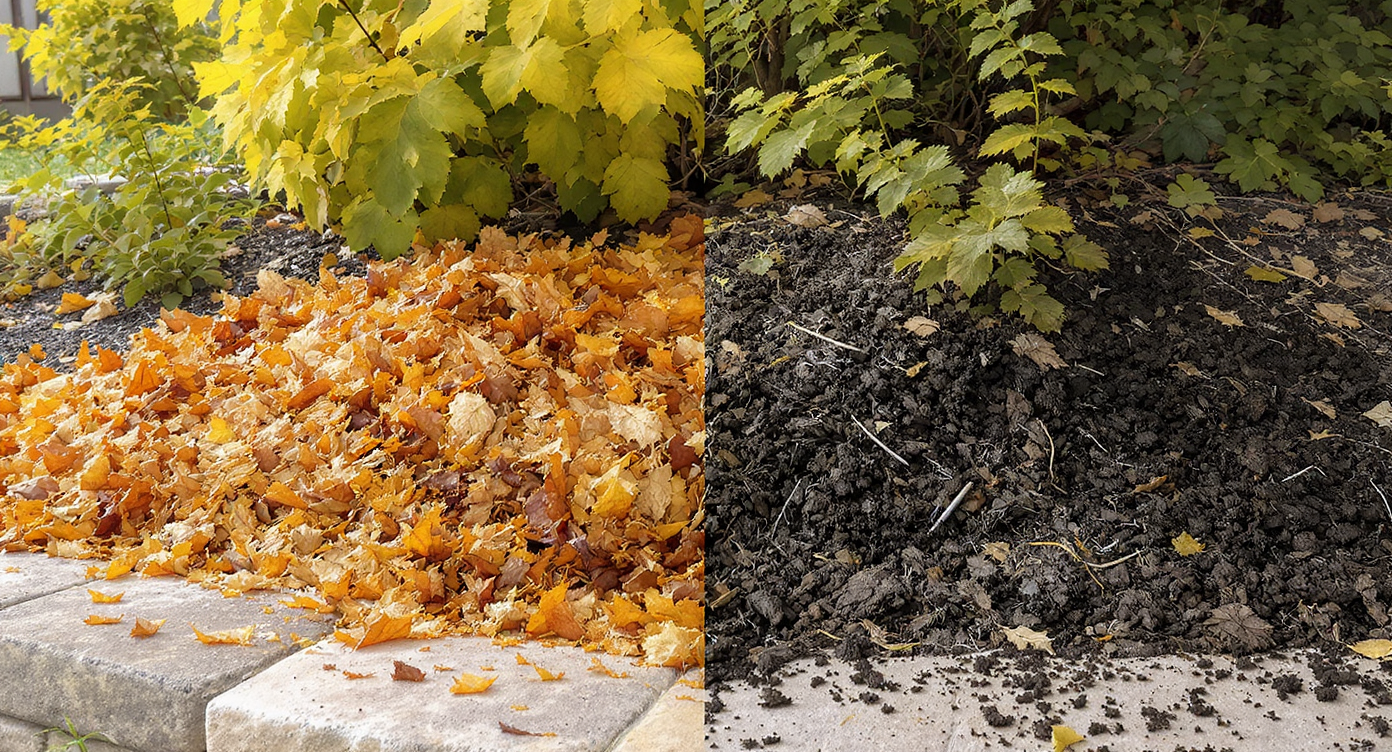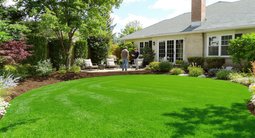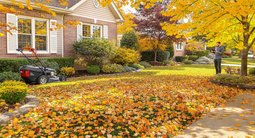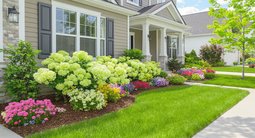TL;DR
Most yards benefit from mulching leaves in place on the lawn and moving excess to beds or woodland edges where a 2–4 inch layer feeds soil and protects roots. Shredding reduces volume by up to 90%, speeds decomposition to one season for most species, and improves curb appeal without endless bagging.
65–80% of fall yard debris is leaves — your introduction to making them work for you

Visualizing leaf zones helps create eco-friendly landscapes that enrich soil and support wildlife.
Leaf management sits at the crossroads of landscaping ideas, garden design, and curb appeal. The short answer: mulch what your lawn can digest, and redeploy the rest as bed mulch or into woodland edges so it feeds soil life and supports wildlife. ReimagineHome.ai, an ai landscape design and ai backyard design partner, lets you visualize those “leaf zones” on a photo of your yard, test how beds expand, and even preview hardscaping design like stone edging or a simple leaf corral before you commit. At a Glance - Mulch in place: Weekly mowing during peak drop turns leaves into fine particles that disappear visually and enrich turf. - Move excess: Spread a 2–4 inch shredded layer in garden beds and woodland edges; keep 2–3 inches of air around trunks. - Species matters: Oak breaks down 2–3 times slower than maple; shredding narrows the gap. - Tools that help: Mulching mower, blower-vac with metal impeller, leaf tarp, and a simple 3-sided bin for passive composting. - Curb appeal boost: Clear primary walkways and entries; leave leaves to work for you in lower-visibility zones.
Try your own layout, furniture style, or celebrity-inspired room transformation on a photo of your space in ReimagineHome.ai.
90% volume reduction with shredding — why landscaping habits are shifting

Mulching shredders can reduce leaf volume by up to 90%, transforming autumn debris into turf-enriching mulch.
Mulching reduces leaf volume by up to 90% because you’re increasing surface area and inviting microbes to work faster. That single fact explains a broader shift: fewer bags at the curb, healthier lawns, and better-looking beds with less store-bought mulch. In water-wise garden design, leaves are a renewable, on-site material. If you’re rethinking how your landscape supports pollinators, low-water planting, and year-round structure, this approach pairs neatly with layered planting and restraint in hardscape. A useful companion to this mindset is designing for curb appeal without high inputs. If you’re updating bed lines or entry sequencing, consider the guidance in this pro-level curb appeal playbook, then let your leaves provide most of the fall and winter mulch. It’s a small change with an outsized effect on maintenance. Finally, a note on equipment: blower-vacs with a metal impeller survive sticks and acorns, and corded or battery mulching mowers make fast work of weekly cleanups. Many homeowners find a weekly pass during peak drop is quicker than occasional marathon rakes — and looks better day to day.
Anecdote
A homeowner in a wooded Mid-Atlantic lot stopped bagging 50–60 paper sacks each fall. They switched to a weekly mulch-pass, then raked the overflow into a rotating woodland strip. The next spring the lawn thickened, the entry felt tidier, and the paper bags were gone from the garage.
3–5 practical trends in leaf-smart landscaping and hardscaping

Leaf-smart trends combine practical hardscaping and efficient mulch practices for easy autumn cleanup.
Three to five practices dominate modern leaf management because they balance ecology and appearance: - 1–2 inches on lawn, 2–4 inches in beds: Most turf can handle about an inch of shredded leaf cover per mowing; move extra into beds where 2–4 inches suppress weeds and insulate roots. - 2–3 inch tree collar: Keep mulch and leaf layers 2–3 inches away from trunks to prevent rot and pests; widen that ring to 6–12 inches for young trees. - 3–5 months to decompose when shredded: Maple and ash disappear fastest; oak takes longer unless mulched finely. Moist, fungal-rich soils move the needle. - 10:1 compaction via shredding: A mulching mower or vacuum turns ten bags into one, which is why bagging less often suddenly makes sense. - 1 photo to plan zones: Use an ai landscape generator from photo to map “lawn,” “bed,” and “woodland edge” so cleanup has a destination. If you’re reshaping beds or experimenting with wilder, water-smart planting that thrives under leaf mulch, explore this water-smart, curb-appeal guide. It shows how layered planting and simple hardscaping ideas — think stone patio borders or gravel paths — benefit from organic mulch like shredded leaves.
5-step AI workflow — use ReimagineHome.ai to plan leaf zones before you rake

Plan your leaf zones effortlessly with a five-step AI workflow using ReimagineHome.ai before raking.
Five steps make ReimagineHome.ai a leaf-season ally for ai yard design: - Step 1 — Upload 1 exterior photo: Front yard, backyard, or the woodland edge you plan to use for leaf drop. - Step 2 — Sketch 2–3 zones: Lawn to mulch in place, beds to expand, and a discreet leaf corral or compost nook behind screening shrubs. - Step 3 — Test 2 edging options: Visualize stone, steel, or brick edges that hold a 2–4 inch leaf layer neatly. This ties natural mulch to crisp hardscaping design. - Step 4 — Preview lighting and entries: Clear sightlines and tidy entries drive curb appeal. Try low, warm outdoor lighting along the main walk so leaf work reads intentional. - Step 5 — Save before/afters: Compare “leaf-smart” layouts to your current yard and share with a partner or your landscaper. When maintenance extends beyond leaves — say, removing aggressive grasses or replanting after a cleanup — you can pair that plan with targeted how-tos like this pampas grass removal and replanting guide. It shows how editing plants and managing debris work hand in hand with a cleaner fall routine.
2–4 months to visible breakdown — real-world leaf stories, results, and lessons

Shredded leaves visibly decompose over 2–4 months, enriching soil and supporting healthy plant growth.
Two to four months is a realistic window to see leaf layers soften and sink when you shred them. In many regions, by late winter you’ll notice the layer has thinned; by mid-spring, it’s largely integrated. - Wooded, 1.5-acre lot: One homeowner mulches weekly with a riding mower, then blows excess into rotating woodland zones. By spring, last year’s shredded layer is gone, soil is darker, and lawn density improves without extra fertilizer. - Oak-heavy New England yard: They bag oak leaves with a mower bag, then run them through a blower-vac to further shred before spreading in shrub beds. The double-cut reduces the stubborn leaf edges that otherwise linger. - Pacific Northwest garden: Big-leaf maple leaves are mulched and left in place on beds. Damp winters accelerate breakdown; by mid-spring the “mulch” reads as finished compost and bulbs punch through cleanly. Micro lesson: spread, don’t pile. Thick, unshredded stacks can mat, exclude air, and slow decomposition dramatically; a thin, shredded layer feeds soil organisms and keeps the look intentional.
Visualization Scenario
Upload a straight-on shot of your front walk into ReimagineHome.ai. Sketch a slightly wider bed at the base of your street tree, add a tidy steel edge, and preview a 2–4 inch leaf layer inside the new line. Save the before/after and decide, in minutes, whether to extend the look down the rest of the block.
7 quick answers — decomposition times, oak vs. maple, mulching safety, and more
Q: Do leaves kill grass if I leave them? A: A thin, shredded layer does not. Most lawns can handle about 1 inch of shredded leaves per mowing; beyond that, move excess to beds or woodland edges. Q: How long do shredded leaves take to decompose? A: Typically 3–5 months for maples and many mixed species; oak can take longer unless finely shredded and spread thinly. Q: Is it okay to dump leaves in my woods? A: Yes, spread them thinly and rotate drop zones each year. Avoid large, repeated piles in one spot. Q: Are oak leaves bad for gardens? A: No. They’re slower to break down whole, but once shredded they make excellent, long-lasting mulch. Q: How thick should leaf mulch be in beds? A: Aim for 2–4 inches. Keep a 2–3 inch gap around trunks and woody stems. Q: Will mulching increase thatch? A: No. Shredded leaves decompose into the soil and do not create thatch; they can actually improve microbial activity. Q: Should I burn leaves? A: Only if it’s legal and safe in your area, but mulching is cleaner, faster, and better for soil and neighbors. Q: What tools work best for a small city lawn? A: A mulching mower, a blower-vac with a metal impeller, and a leaf tarp for quick transport cover most needs. Alt: “Front walk cleared with crisp stone edging, beds mulched with shredded leaves, and a woodland edge zone planned in ReimagineHome.ai.” Caption: “ReimagineHome.ai helps you map lawn, bed, and woodland zones so leaves become mulch, not mess.”
Before you rearrange a room or invest in new furniture, explore a celebrity-inspired version of your space in ReimagineHome.ai — a low-risk, high-creativity way to preview ideas before committing in real life.
2–3 inches from trunks, 2–4 inches on beds — pro mistakes to skip and pro tips to keep
Keep 2–3 inches of space around trunks and aim for a 2–4 inch shredded layer in planting beds — that single rule prevents most leaf-related problems. Common mistakes include burying tree flares, leaving thick unshredded blankets on turf, making the same dump pile every year, and relying on plastic impellers that can shatter on hidden gravel. Pro tips for a smoother season: - Schedule weekly mulching during peak drop; it’s faster than playing catch-up. - Use a metal-impeller blower-vac for durability and a 12-gauge cord if you go corded. - Create a simple 3-sided leaf bay from block or wire; turn it once in spring for crumbly compost by fall. - Clear primary paths and entries first; let back-of-lot areas keep their wild mulch. - If nitrogen is low, balance a leaf pile with green material (fresh clippings) to speed decay rather than reaching for synthetics. For a bigger curb appeal refresh that still respects low-maintenance, leaf-forward planting, study these curb appeal strategies you can visualize, then test the look in ReimagineHome.ai before you edge a single bed.
.svg)

.svg)














.png)